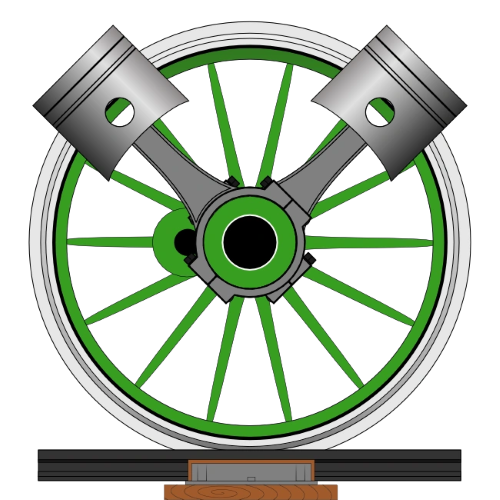British Rail Class 58 are CoCo Diesel-Electric locomotives designed for heavy freight & were unusual as they somewhat copied American modular design practice. First to revenue duty in 1983 & withdrawn from BR\EWS service in 2002, then 32 were hired abroad: 4 to the Netherlands, 8 to Spain, 20 to France.
Development[]
In the late 1970s, British Rail wanted to develop a new, low-cost, easily maintained freight locomotive that would handle the predicted rail freight growth during the 1980s. The Class 56 had a troublesome entry into service, and BR was also keen to enter the export market. Pre-production drawings of the Class 58s referred to them as "Standard Export Locomotives".
Once a design for the new Class 58 had been approved by the British Railways Board, the contract to build the locomotives was awarded to British Rail Engineering Limited's (BREL) Doncaster Works where work started on a major multi-million pound upgrade of ‘E2’ shop where the locomotives would be manufactured. BREL dropped traditional locomotive construction methods in favour of an entirely new approach – an innovative modular design. This offered savings on construction and maintenance compared to previous locomotive builds. The load-bearing underframe was fitted with exchangeable modules - number 1 cab, radiator, power unit, turbocharger, electrical equipment and number 2 cab. If required, each module could be easily removed from the underframe and replaced.
The narrow body with cabs at either end led to them being given the nickname "Bone" by rail enthusiasts, but the design also made an American-style single cab version possible.
Service In Britain[]
The first locomotive, 58001, was handed over to British Rail at Doncaster Works on 9 December 1982 and delivery of the remainder of the locomotives continued until early 1987 with the final delivery of 58050. This loco was temporarily fitted with a SEPEX wheelslip control system, but upon completion experimental testing the equipment was removed before the locomotive entered traffic. SEPEX was central to the design of the Class 60. No export orders were received and so the jigs at Doncaster were dismantled and 58050 became not only the last Class 58 to be built, but the last diesel locomotive to be built at 'The Plant'.
Since they were introduced in the early 1980s, the 58s saw service on a variety of freight duties. Despite claims made at the time, their performance was actually inferior to Class 56s on many types of freight train due to their increased tendency to wheelslip, largely as a result of bogie design. Although originally allocated to coal traffic, their arrival coincided with the miners' strike, and British Rail apparently only tolerated the construction of so many units because the components were already on order. As a result, the 58s could also be seen working other types of freight traffic. With the advent of privatisation in the 1990s, Class 58s greatly extended the geographical scope of their operations and were used on general freight traffic until withdrawal.
In their day, Class 58s were powerful and capable freight locomotives, although not without their flaws. However, by the turn of the century they compared unfavourably with the new generation of locomotives and were quickly supplanted by Class 66s. In comparison, Class 58s were expensive to maintain and operate, and delivered much lower availability.
Withdrawal[]
In the late 1990s, with the Class 58 considered the most reliable\consistent EWS Type5 locomotive, it was assumed they would continue in service for many years. However, it was announced in 1999 that a large number of Class 58s would be placed into longterm storage: 58017 was the first to be stored, quickly followed by 58022. By 2002Sep, all Class 58s were in storage at various locations around Britain. They had generally been replaced by new Class 66 locomotives. The last Class 58 charter train was the "Bone Idol" from King's Cross to Skegnessand & return.
Seven Class 58s were put on the DB Schenker disposal list 2010Apr. This is the first time stored Class 58s have been put up for sale. One of these, 58016, entered preservation at Barrow Hill with the Class 58 Locomotive Group (C58LG).
Five class 58s were listed for disposal by DB Schenker October 2015 disposals list. Namely 58008, 58012, 58022, 58023, and 58048.
According to Railways Illustrated for August 2014: "..the story of the 58s has been one of a shocking waste - they were nowhere near life-expired when withdrawn and to see them sitting in depots in France when there is a shortage of locos in the UK is baffling..."
Disposal[]
In January 2016 it was reported that DB Schenker had disposed of its last Class 58s. Of these 58 012, 58 022, 58 023, & 048 were saved, but 58 008 is to be scrapped by Raxstar.
Service In Europe[]
EWS announced in 2000 that eight Class 58s were to be moved to Spain (on hire to Spanish infrastructure operator GIF) and later, a large number of Class 58s (alongside Class 56s) operated in France for Fertis, TSO and Seco Rail.
In May 2007, all of the locomotives from the French contract were returned to the UK and placed back into storage. The Spanish locomotives remain active however now under the ownership of Transfesa. The locomotives that were returned to the UK were sent back abroad to France from May–October 2009 on hire to operators TSO and ETF. The Dutch locomotives were prepared for further use in France before being transported to France in July 2009.




